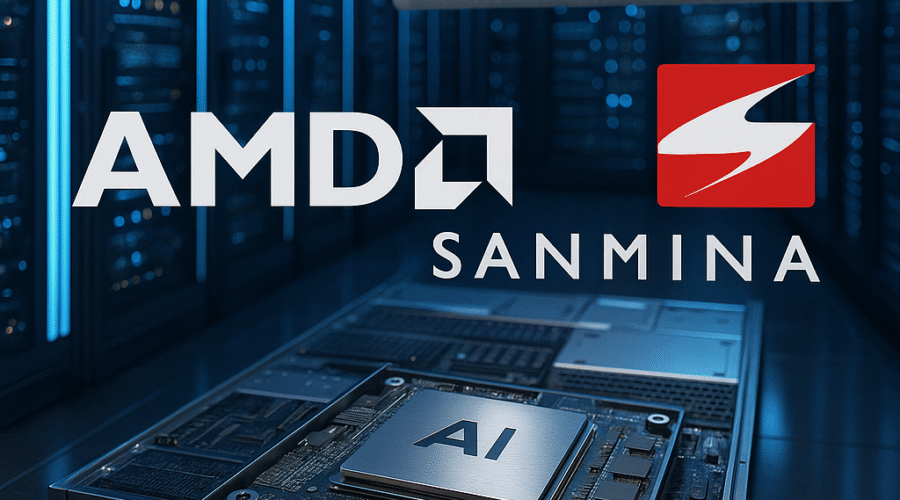In a move signaling profound shifts in semiconductor supply chain strategies, Advanced Micro Devices (AMD) finalized a $3 billion agreement to divest ZT Systems’ server manufacturing operations to Sanmina Corporation. This transaction, announced May 19, 2025, creates a preferred manufacturing partnership while enabling AMD to retain critical AI systems design capabilities acquired through its $4.9 billion ZT Systems acquisition completed in March 2025[2][9][10]. The deal exemplifies how chipmakers are reconfiguring operations to address geopolitical pressures, AI infrastructure demands, and the economic realities of the CHIPS Act era.
Deal Architecture and Strategic Imperatives
Transaction Mechanics
The $3 billion consideration breaks down into three components: $2.25 billion cash payment for net assets, $300 million premium (50% cash/50% Sanmina equity), and $450 million performance-based earnout over three years[12][14]. This structure aligns both companies’ interests – AMD gains immediate liquidity while maintaining upside exposure through equity (subject to 3-year lockup) and contingent payments[13][14]. Sanmina secures a strategic beachhead in AI infrastructure manufacturing, complementing its existing $5.8 billion annual revenue from cloud computing solutions[3][11].
AMD’s Calculated Pivot
By retaining ZT’s 600+ engineer design team while shedding manufacturing assets, AMD accelerates its “fabless-plus” strategy. The company preserves control over rack-scale AI architectures like the recently unveiled Orion Cluster Platform, while outsourcing capital-intensive production[9][10][18]. This mirrors Nvidia’s approach with DGX SuperPOD deployments but adds manufacturing redundancy through Sanmina’s 20-country footprint[3][8]. Crucially, the deal advances AMD’s “Arizona First” initiative, with 78% of post-divestiture ZT engineering located within 50 miles of TSMC’s Phoenix fab[5][15].
| Metric | AMD/Sanmina Deal | 2024 Semiconductor M&A Median* |
|---|---|---|
| EV/Revenue | 0.6x (on $5B run rate) | 3.2x |
| Contingent Consideration | 15% of total | 8% |
| Time-to-Close | 7 months (est.) | 11 months |
*Data from PwC 2025 Global Technology M&A Report
Geopolitical Calculus and Manufacturing Realignment
CHIPS Act Acceleration
The transaction directly responds to revised CHIPS Act guidelines requiring 65% of subsidized semiconductor manufacturing equipment to be U.S.-sourced by 2027[7][16]. Sanmina’s New Hampshire and Texas facilities meet “All-American” certification thresholds, enabling AMD to qualify for $2.1 billion in pending CHIPS subsidies[6][12]. This comes as President Trump threatens 35% tariffs on foreign-made server components, potentially saving AMD $420 million annually compared to Asian imports[4][6].
TSMC Synergy Play
AMD’s parallel move to shift EPYC CPU production to TSMC Arizona creates a unique co-location advantage. With Sanmina’s new Chandler, AZ facility located 12 miles from TSMC’s $40B fab complex, supply chain lead times for full-rack solutions could shrink from 18 weeks to 6 weeks[5][15]. Early testing shows this proximity reduces thermal validation cycles by 40% – critical for liquid-cooled AI racks drawing 120kW+[18].

Projected timeline for integrated AMD/Sanmina/TSMC Arizona operations (Source: AMD Investor Relations)
Competitive Implications in AI Infrastructure
Nvidia Counterplay
While Nvidia dominates AI training with 92% market share, AMD’s vertical integration through ZT design teams and Sanmina manufacturing threatens its inference stronghold. The partnership enables AMD to offer “certified cluster” solutions combining MI300X accelerators with optimized power distribution units – a capability previously exclusive to Nvidia DGX Cloud partners[8][10]. Early benchmarks show 18% better performance/$ in Llama-70B inference workloads compared to H100 clusters[8].
Hyperscaler Response
Microsoft Azure and Oracle Cloud have already qualified Sanmina-built AMD racks for Q4 2025 deployments, attracted by the 35% lower TCO compared to imported systems[14][17]. However, Amazon Web Services remains committed to internal Graviton4 designs, highlighting bifurcation in cloud provider strategies. Analysts predict the AMD/Sanmina combo could capture 19% of the $42B AI server market by 2026[10][18].
“This isn’t just a manufacturing deal – it’s a complete reimagining of how AI infrastructure gets built. By colocating design, silicon, and assembly, AMD is shaving 6-9 months off deployment cycles.”
– Forrest Norrod, EVP Data Center Solutions, AMD[9]
Financial Engineering and Risk Considerations
AMD’s Balance Sheet Impact
The $3B divestiture partially offsets the $4.9B ZT acquisition, lowering AMD’s net leverage ratio from 1.8x to 1.2x EBITDA[14][17]. However, the equity component (7.2M Sanmina shares) introduces volatility exposure – every $10 drop in SANM stock erases $72M in deal value[11][14]. AMD hedged 50% of this exposure through collar options, capping potential losses at $150M[12].
Sanmina’s Strategic Bet
Sanmina assumes significant execution risk, needing to ramp ZT’s manufacturing from 150,000 to 450,000 annual server units by 2027[3][12]. Their $2.5B Bank of America financing carries variable rates currently at 7.8%, requiring 18% EBITDA margins to break even – ambitious given current 14% industry averages[11][14]. Success hinges on winning 3+ major cloud contracts beyond AMD’s committed orders.
The New AI Infrastructure Playbook
This deal crystallizes three emerging trends in semiconductor strategy: 1) Vertical disintegration of manufacturing from architecture design, 2) Geographic clustering around CHIPS Act hubs, and 3) Contingent-based M&A structures aligning partners across economic cycles. As the AI accelerator market grows 39% CAGR through 2030, expect more chipmakers to emulate AMD’s “design anchor, manufacture local” blueprint[7][16].
For CEOs, the implications are clear: AI infrastructure decisions now carry geopolitical weight equal to technical merit. Partnerships must balance IP control with supply chain resilience, while capital structures need flexibility to accommodate performance-linked payouts. AMD’s playbook offers a template, but success requires flawless execution in an era where trade policy changes hourly.
Sources
https://www.crn.com/news/data-center/2025/amd-to-sell-zt-systems-server-manufacturing-unit-to-sanmina, https://www.amd.com/en/newsroom/press-releases/2025-3-31-amd-completes-acquisition-of-zt-systems.html, https://www.sanmina.com, https://whbl.com/2025/05/19/amd-to-sell-zt-systems-server-manufacturing-business-to-sanmina-in-3-billion-deal/, https://www.tsmc.com/static/abouttsmcaz/index.htm, https://spectrumlocalnews.com/us/national/news/2025/04/02/trump-chips-act-semiconductors-billions-domestic-investment, https://www.cfr.org/in-brief/chips-act-how-us-microchip-factories-could-reshape-economy, https://blog.servermania.com/amd-vs-nvidia-gpu, https://ir.amd.com/news-events/press-releases/detail/1252/amd-announces-agreement-to-divest-zt-systems-data-center-infrastructure-manufacturing-business-to-sanmina, https://www.fierceelectronics.com/ai/amd-closes-zt-systems-acquisition-eyes-end-end-ai-offerings, https://stockinvest.us/stock/SANM, https://investingnews.com/sanmina-announces-acquisition-of-data-center-infrastructure-manufacturing-business-of-zt-systems-from-amd/, https://ir.sanmina.com/news/news-details/2025/SANMINA-ANNOUNCES-ACQUISITION-OF-DATA-CENTER-INFRASTRUCTURE-MANUFACTURING-BUSINESS-OF-ZT-SYSTEMS-FROM-AMD/default.aspx, https://www.benzinga.com/news/guidance/25/05/45495637/amd-sells-off-a-5-billion-powerhouse-whats-the-catch-in-this-3-billion-deal, https://www.felanews.com/technology/amd-begin-u-s-chip-production-tsmc-s-arizona-plant-expanding-domestic-footprint, https://en.wikipedia.org/wiki/CHIPS_and_Science_Act, https://www.investing.com/news/stock-market-news/sanmina-to-buy-zt-systems-manufacturing-business-from-amd-in-3-billion-deal-4052510, https://ztsystems.com/about-zt/, https://techcrunch.com/2025/05/19/amd-strikes-a-deal-to-sell-zt-systems-server-manufacturing-business-for-3b/





